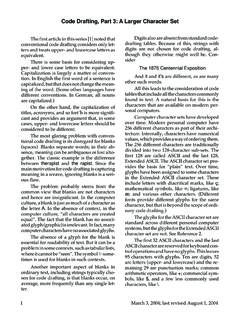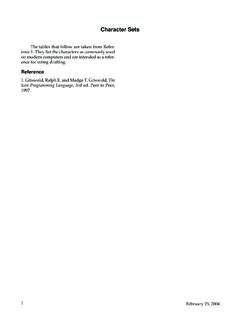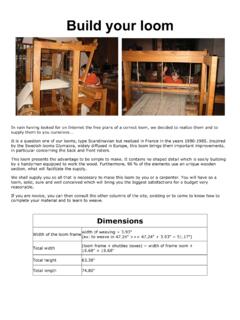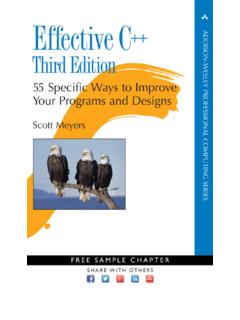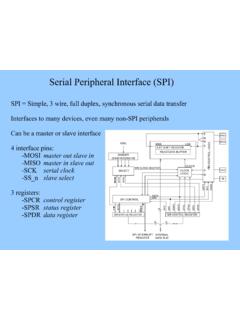Transcription of Object-Oriented Design Patterns - University of Arizona
1 CSC 335: Object-Oriented Programming and Design Object-Oriented Design Patterns Outline Overview of Design Patterns Four Design Patterns Iterator Decorator Strategy Observer The Beginning of Patterns Christopher Alexander, architect A Pattern Language--Towns, Buildings, Construction Timeless Way of Building (1979). Each pattern describes a problem which occurs over and over again in our environment, and then describes the core of the solution to that problem, in such a way that you can use this solution a million times over, without ever doing it the same way twice.. Other Patterns : novels (tragic, romantic, crime), movies genres (drama, comedy, documentary).
2 Gang of Four (GoF) Book Design Patterns : Elements of Reusable Object-Oriented Software, Addison-Wesley Publishing Company, 1994. Written by this "gang of four". Dr. Erich Gamma, then Software Engineer, Taligent, Inc. Dr. Richard Helm, then Senior Technology Consultant, DMR Group Dr. Ralph Johnson, then and now at University of Illinois, Computer Science Department Dr. John Vlissides, then a researcher at IBM. Thomas J. Watson Research Center See John's WikiWiki tribute page Object-Oriented Design Patterns This book defined 23 Patterns in three categories Creational Patterns deal with the process of object creation Structural Patterns , deal primarily with the static composition and structure of classes and objects Behavioral Patterns , which deal primarily with dynamic interaction among classes and objects Documenting Discovered Patterns Many other Patterns have been introduced documented For example, the book Data Access Patterns by Clifton Nock introduces 4 decoupling Patterns , 5 resource Patterns , 5 I/O Patterns .
3 7 cache Patterns , and 4 concurrency Patterns . Other pattern languages include telecommunications Patterns , pedagogical Patterns , analysis Patterns Patterns are mined at places like Patterns Conferences ChiliPLoP. Recent Patterns books work shopped at ChiliPLoP, Wickenburg and Carefree Arizona Patterns of Enterprise Application Arhitecture Martin Fowler Patterns of Fault Tolerant Software, Bob Hamner Patterns in XML Fabio Arciniegas Patterns of Adopting Agile Development Practices Amr Elssamadisy 2010: Patterns of Parallel Programming, Ralph Johnson 16 Patterns and one Pattern Language work shopped GoF Patterns Creational Patterns Behavioral Patterns Abstract Factory Chain of Responsibility Builder Command Factory Method Interpreter Prototype Iterator Singleton Mediator Structural Patterns Memento Adapter Observer Bridge State Composite Strategy Decorator Template Method Fa ade Visitor Flyweight Proxy Why Study Patterns ?
4 Reuse tried, proven solutions Provides a head start Avoids gotchas later (unanticipated things). No need to reinvent the wheel Establish common terminology Design Patterns provide a common point of reference Easier to say, We could use Strategy here.. Provide a higher level prospective Frees us from dealing with the details too early Other advantages Most Design Patterns make software more modifiable, less brittle we are using time tested solutions Using Design Patterns makes software systems easier to change more maintainable Helps increase the understanding of basic object - oriented Design principles encapsulation, inheritance, interfaces, polymorphism Style for Describing Patterns We will use this structure: Pattern name Recurring problem: what problem the pattern addresses Solution: the general approach of the pattern UML for the pattern Participants.
5 A description as a class diagram Use Example(s): examples of this pattern, in Java A few OO Design Patterns Coming up: Iterator access the elements of an aggregate object sequentially without exposing its underlying representation Strategy A means to define a family of algorithms, encapsulate each one as an object , and make them interchangeable Observer a preview One object stores a list of observers that are updated when the state of the object is changed Iterator Pattern: Iterator Name: Iterator ( Enumeration). Recurring Problem: How can you loop over all objects in any collection. You don't want to change client code when the collection changes.
6 Want the same methods Solution: 1) Have each class implement an interface, and 2) Have an interface that works with all collections Consequences: Can change collection class details without changing code to traverse the collection GoF Version of Iterator page 257. ListIterator First(). Next(). IsDone(). CurrentItem(). // A C++ Implementation ListIterator<Employee> itr = ();. for( (); ! (); ()) {. cout << ().toString();. Java version of Iterator interface Iterator boolean hasNext(). Returns true if the iteration has more elements. object next(). Returns the next element in the iteration and updates the iteration to refer to the next (or have hasNext() return false).}
7 Void remove(). Removes the most recently visited element Java's Iterator interface // The Client code List<BankAccount> bank =. new ArrayList<BankAccount>();. (new BankAccount("One", ) );. // .. (new BankAccount("Nine thousand", ));. String ID = "Two";. Iterator<BankAccount> itr = ();. while( ()) {. if( ().getID().equals( ())). ("Found " + ());. }. UML Diagram of Java's Iterator with a few Collections <<interface>>. <<interface>>. List Iterator iterator(): Iterator hasNext(). next(). Vector LinkedList ArrayList Iterator iterator() iterator() iterator() hasNext(). next(). Client Decorator Design Pattern Rick Mercer CSC 335: Object-Oriented Programming and Design The Decorator Pattern from GoF.
8 Intent Attach additional responsibilities to an object dynamically. Decorators provide a flexible alternative to sub classing to extend flexibility Also Known As Wrapper Motivation Want to add properties to an existing object . 2 Examples Add borders or scrollbars to a GUI component Add stream functionality such as reading a line of input or compressing a file before sending it over the wire Applicability Use Decorator To add responsibilities to individual objects dynamically without affecting other objects When extending classes is impractical Sometimes a large number of independent extensions are possible and would produce an explosion of subclasses to support every combination (this inheritance approach is on the next few slides).
9 An Application Suppose there is a TextView GUI component and you want to add different kinds of borders and/or scrollbars to it You can add 3 types of borders Plain, 3D, Fancy and 1 or 2 two scrollbars Horizontal and Vertical An inheritance solution requires15 classes for one view That's a lot of classes! Disadvantages Inheritance solution has an explosion of classes If another view were added such as StreamedVideoView, double the number of Borders/Scrollbar classes Solution to this explosion of classes? Use the Decorator Pattern instead VisualComponent draw() 1. resize(). TextView SteamedVideoView Decorator 1. draw() draw() draw().
10 Resize() resize() resize(). Decorator contains a visual component An imagined example Border ScrollBar draw() draw(). resize() resize(). Plain 3D Fancy Horiz Vert draw() draw() draw() draw() draw(). resize() resize() resize() resize() resize(). Decorator's General Form JScrollPane Any Component such as Container, JList, Panel can be decorated with a JScrollPane The next slide shows how to decorate a JPanel with a JScrollPane Decorate a JPanel JScrollPane scrollPane = new JScrollPane(toStringView);. add(scrollPane); // Add to a JFrame or another panel Motivation Continued The more flexible containment approach encloses the component in another object that adds the border The enclosing object is called the decorator The decorator conforms to the interface of the component so its presence is transparent to clients The decorator forwards requests to the component and may perform additional actions before or after any forwarding Decorator Design : Java Streams InputStreamReader(InputStream in) is an InputStream object .
